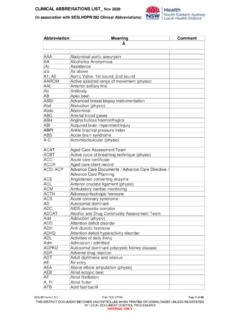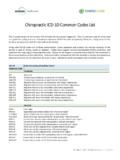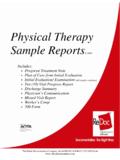Transcription of CRANIOVERTEBRAL JUNCTION : ANATOMY & RADIOLOGY
1 CRANIOVERTEBRAL JUNCTION : ANATOMY & RADIOLOGYP resented By : Dr. SHAILESH JAINCRANIOVERTEBRAL JUNCTION The CRANIOVERTEBRAL (or craniocervical) JUNCTION (CVJ) is a collective term that refers to the occiput( posterior skull base), atlas, axis, and supporting ligaments. It is a transition zone b/w a mobile cranium & relatively rigid spinal column. It encloses the soft tissue structures of the cervicomedullaryjunction (medulla, spinal cord, and lower cranial nerves).EMBRYOLOGY & DEVELOPMENT OF THE CVJ Development of the cartilaginous cranium & the adjacent structures begins during the early weeks of intrauterine life. 2ndGestational week: Mesoderm cells condense in the midline to form notochordalprocess. 3rdGestational week: -notochordalprocess invaginatesin b/w ecto& endoderm to form ectoderm thickens to form neural groove which folds, fuses, & becomes neural & DEVELOPMENT OF THE CVJ Between 3rd& 5thweek: -part of mesoderm which lies on either side of notochord (Paraxial mesoderm) gives rise to somites(Segmentation).
2 -total 42 somitesform at of somiteis k/a sclerotomewhich forms the vertebral sclerotomedifferentiates into a cranial, loosely arranged portion and a caudal compact portion by a fissure k/a Fissure of von Ebner (Re-segmentation).EMBRYOLOGY & DEVELOPMENT OF THE CVJ Mesenchymalcells of the fissure condense around the notochord to form the intervertebraldisc. Notochord disappears at the vertebral bodies, but persist asnucleus pulposusat disc. The first four sclerotomesdo not follow this course & fuse to form the occipital bone & FM. This membraneousstage is f/bstages of chondrification& ossification. Out of 4 occipital sclerotomesthe first 2 form basiocciput, the III Jugular tuberclesand the IV (Proatlas) form parts of foramen magnum, atlas and & DEVELOPMENT OF THE CVJ PROATLAS: divided into the hypocentrum, centrum& the neural the vestigial condylustertiusor anterior tubercle of the the apex of the dens, also forms the apical ligament (AL) of dens (AL may contain notochordaltissue,sok/a rudimentary IVdisc).
3 -ventral part of the neural arch forms the ant. margin of FM, 2 occipital condyles& the alar& part forms paired rostralarticularfacets, lateral masses of C1 & superior portion of the post. arch of the & DEVELOPMENT OF THE CVJ ATLAS: no vertebral body & no IV portion formed by first spinal as centrumof sclerotomeis separated to fuse with the axis body forming the 1stspinal sclerotomeforms the anterior arch of the arch of the first spinal sclerotomeforms the inferior portion of the posterior arch of & DEVELOPMENT OF THE CVJ AXIS: develops from 2ndspinal 2ndspinal sclerotomedisappears during the body of the axis vertebra & neural arch develops into the facets & the posterior arch of the birth odontoidbase is separate from the body of axis by a cartilage which persists until the age of 8, later the center gets ossified.
4 ,ormay remain separate apical segment is not ossified until 3 years of age, at 12 years if fuses with odontoidto form normal odontoid., failure leads to Os CENTRES OCCIPUT & BASIOCCIPUT:2 occipital squamousportions 2 centresBasiocciput(clivus) -1 centre2 Jugular tubercles 2 centres2 Occipital condyles 2 centres ATLAS: ossifies from 3 centresEach half of post. Arch with lateral mass 7 to 9 wk,unites at 3 4 arch at 1 to 2 years centre appears,unites with lateral mass at 6 8 CENTRES AXIS: ossifies from 5 primary & 2 secondary Neural arches 2 centresappear at 7 8 wkBody of axis 1 centre appear at 4 5 monthsBody of dens 2 centresappear at 6 7 months4 pieces (at birth) unite at 3 6 yearsTip of odontoidappears at 3 6 years, unites with the body of odontoidat 12 body of axis only circumference of intervening cartilage Dysplasiaof the occiptalsegments may flatten the clivus-platybasia.
5 When the basiocciputand rim of foramen magnum are underdeveloped, the odontoidand arch of atlas may invaginate-Basilar invagination. The proatlasmay develop into separate vertebrae -Occipital vertebra, hypochondralbow of proatlasmay persist to gain attachment to the atlas, clivusor even to the apical segment of the dens -responsible for anterior If the posterior segment of the proatlasfails to fuse with the atlas, a rare anomaly termed bipartite articularfacetsoccurs, may result in horizontal instability of the OA joint. Bicornuatedens : dens body may fail to fuse in uteroresulting in a V-shaped cleft found radiographicallyat birth , rare in adults. Failure of segmentation b/w the axis & the 3rdcervical vertebra involves both the ant. & the post. Vertebral segments, associated with other anomalies like Klippel OF CVJ (SKELETAL) ANATOMY OF CVJ (ARTICULAR) Upper surfaces of C1 lateral masses are cup-like or concave which fit into the ball & socket configuration, united by articularcapsules surr.
6 The AO joint & by the ant. & post. AO membranes. 4 synovialjoints b/w atlas & axis 2 median front & back of dens (Pivot variety)2 lateral b/w opposing articularfacets(Planevariety) Each joint has its own capsule & OF CVJ(LIGAMENTOUS) Principal stabilizing ligaments of C1 --Transverse atlantalligament-Alarligaments Secondary stabilizing ligaments of CVJ are more elastic & weaker than the primary ligament-Anterior & posterior A-O membranes-Tectorialmembrane-Ligamentumfl avum-ALL & PLL-Capsular ligaments ANATOMY OF CVJ(LIGAMENTOUS)ATLANTO-OCCIPITAL LIGAMENTS: A) Anterior Atlanto-occipital Membrane ---- about 2 cm wide & consists of densely woven fibresthat radiate in a slightly lateral pattern. Central fibresare thicker than the lateral portion. Lateral fibresinterconnect with the A-O capsules. Ligament is continuous caudally with the anterior A-A ligament & through it to the ALL of the spinal column.
7 It acts as a tension band that stretches during extension, serving as a secondary stabilizer against this OF CVJ(LIGAMENTOUS)B) posterior ATLANTO-OCCIPITAL MEMBRANE: A less strong ligament containing no significant elastic tissue. Ligament is loose b/w the bones & does not limit their motion & is firmly attached anteriorlyto the duramater. Ligament invests itself on either side to form a canal through which the vertebral artery, accompanying veins, & the first cranial nerve ) LATERAL ATLANTO-OCCIPITAL LIGAMENTS:-ascending ligwhich reinforce the A-O joint OF CVJ(LIGAMENTOUS)ATLANTOAXIAL LIGAMENTS: Anterior A-A ligament, posterior A-A ligament Transverse ligament of the atlas: thick, strong & about 6mm in a fibrocartilagenoussurface ventrally allowing a free gliding motion to occur over the posterior facet of the fibresof this ligament are arcuate, & the more ventral fibresare circular in OF CVJ(LIGAMENTOUS) Caudal crus& Rostralcrus(Fasciculilongitudinales) fibresjoined with transverse ligament on its dorsal aspect to form Cruciateligament of atlas.
8 The force required to rupture the transverse ligament ranged from 12 to 180 kp(mean 84kp) under slow loading & about 111 kpunder rapid loading. TAL effectively limits anterior translation and flexion of the atlantoaxialjoint. An accessory band ventral to the ascending crusattaching to the apex of the odontoidprocess is termed Gerber s OF CVJ(LIGAMENTOUS)AXIS OCCIPITAL LIGAMENTS: A) TECTORIAL MEMBRANE: dorsal to the cruciateligament, a strong band of longitudinally oriented fibresattached to the dorsal surface of the C3 vertebra, axis body ,& to the body of dens. It is the rostralextension of the PLL of the vertebral column. Essential for limiting flexion. The accessory bands of the ligament passing to the lateral capsule of the A-A joints --Arnold s ligamentANATOMY OF CVJ(LIGAMENTOUS)B) ALAR LIGAMENTS: 2 strong cords that attach to the dorsal lateral body of the dens , about 8mm wide.
9 Fibresextend laterally & rostrally. They are ventral & cranial to the transverse ligament. Alarligallow an anterior shift of C1 from 3 to 5 mm. They limit the head atlas rotatorymovement on the odontoidaxis as well as strengthen the A-O ) APICAL LIGAMENT: slender band of fibresabout 2-5mm wide & 2-8mm long containing small amount of collagen & elastic fibres. No mechanical OF CVJ (MUSCLES) Muscles have only a minor role related to CVJ stabilization & do not limit the movements of the joints. Their principal function is one of initiating & maintaining movement at the OF CVJ (NEURAL) Neural structures related to CVJ are Caudal portion of brainstem (Medulla)CerebellumFourth ventricleRostralpart of spinal cordLower cranial & upper cervical nerves In cerebellum, only the tonsils, biventrallobules & the lower part of the vermis(nodule, uvula & pyramid) are related to CVJ.
10 Biventrallobule is located above the lateral part of FM & the tonsils lie above the posterior OF CVJ (NEURAL)CRANIAL NERVES : Lower four cranial N. are closely related to CVJ. 9th& 10thcranial N arise from the medulla in the groove b/w the inferior olivarynucleus & the inferior cerebellarpeduncle. 9th& 10thN are separated by a duralsheath which separate these nerves as they penetrate the durato enter the jugular foramen. The accessory N is the only cranial N that passes through the OF CVJ (NEURAL) Accessory N is composed of 2 parts. The cranial part or the accessory portion (ramusinternus)is the smaller of the two & is accessory to the vagus. It arises from the medulla, is composed of multiple rootlets & joins the vagusN. The major portion (ramusexternus)is the spinal portion formed by a series of rootlets arising from the lower medulla & upper spinal cord. The rootlets may arise as low as the C7 root OF CVJ (NEURAL) Major trunk enters the skull via FM b/w dentate lig& dorsal roots where it joins the cranial portion of the N & leaves the skull through the jugular foramen.




